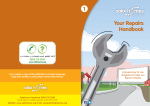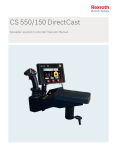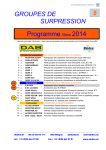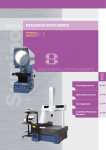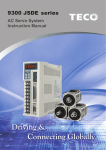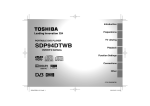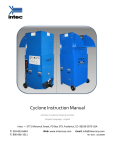Download Rena DA-590 Instruction manual
Transcript
TB-356/356 S Conveyor / Stacker INSTRUCTION MANUAL Rev. 3/17/04 Part#: M-3027 RENA Systems, Inc. 136 Green Tree Rd Ste 140 PO Box 1069 Oaks, PA 19456-1069 Telephone: 610/650-9170 Fax: 610/650-9171 Every effort has been made to assure the accuracy of this manual. RENA Systems shall not be held liable for any errors contained herein or for any consequential or incidental damages incurred as a result of acting on information contained in this manual. Technical specifications may change due to design advances. The data stated are nominal values only. CONTENTS TB-356/356 S INSTRUCTION MANUAL Page Chapter Important notes on safety 1 Introduction What does the TB356 conveyor/stacker do? The parts of the TB356 conveyor/stacker Technical data 2 Installing the conveyor Assembling the conveyor Stacker assembly 2.1 2.1 2.1 2.2 Positioning the conveyor Connecting power 2.2 N.1 Changing the fuses Operation (setting up the conveyor) Connecting the power cable Using the transport wheels Operating the conveyor Using the ink blotter roll Changing the paper roll Replacing the paper roll 4 1.1 1.2 1.3 Setting the form length Selecting the voltage 3 1.1 Optional Accessories Vertical paper stacker Floor stand Floor stand assembly instructions Cross support stacker (lateral transport) N.1 N.2 3.1 3.1 3.1 3.2 3.2 3.3 3.3 4.1 4.1 4.2 4.3 4.4 Important Notes on Safety PLEASE READ THESE INSTRUCTIONS CAREFULLY KEEP THEM WITHIN EASY REACH FOR LATER USE All direction and warning labels on the conveyor must be observed. Setting up the conveyor Electrical safety • When setting up the conveyor, be sure that it is positioned securely and is level. If it is allowed to tilt, roll away or drop, injuries may result. • The conveyor must be protected from moisture. • When connecting the conveyor to the power supply, observe the rated • • • • • • Operational safety values for the power connection on the name plate. Check the voltage setting on the conveyor’s power input module. For reasons of electrical safety, the power connection socket must be equipped with a grounded conductor contact. The conveyor has double-pole fuse protection! In the event of fuse failure, electrical parts in the conveyor may still be live. Run the power supply cable so that no-one can trip over it. Also make sure that nothing is placed on the cable. If the conveyor remains unused over a long period of time, disconnect it from the power supply. This ensures that no damage will be caused by voltage surges. Never open the conveyor. For reasons of electrical safety, it may be opened only by authorized service personnel. • Never touch the internal parts of the conveyor while it is running ! • To avoid damaging the coveyor, use only parts that have been approved by the manufacturer. Let your RENA service technician check the conveyor ! IN THE FOLLOWING CASES, DISCONNECT THE CONVEYOR FROM THE POWER SUPPLY ! Parts • If a repair is required, use only genuine RENA parts. • • • • The power cable or power socket are damaged. Liquid has penetrated the conveyor. The conveyor was exposed to moisture. If the conveyor does not function as described in the operating instructions, or there is no improvement with the aid of these instructions. • The conveyor was dropped and/or the housing is damaged. • If the conveyor shows clear signs of a defect. Consult your RENA service provider with questions relating to service and repair. This will ensure that your conveyor will operate properly at all times. Introduction Introduction What does the TB-356 conveyor/stacker do? The TB-356 conveyor is a variable speed conveyor that continuously receives material output from another piece of equipment such as a printer or labeler. The conveyor moves the material out of the way and neatly stacks it in sequence in a drop-down stacking tray. Optionally, a roll of blotter paper may be added to assist in the drying of ink on difficult to dry material. \text\tb356\introduction 1.1 TB356 Instruction Manual Introduction The parts of the TB-356 conveyor/stacker: 1. Material transport belt 2. A.C. power receptacle 3. Speed control potentiometer 4. Power cord 5. Hanging catch tray plate 6. Back stop \text\tb356\introduction 1.2 7. Bottom catch tray plate 8. Thumb screw for back stop 9. Transport wheels 9a. Optional paper blotter roll 10. Power switch TB356 Instruction Manual Introduction Technical Data Dimensions LxWxH with Stacker 856mm x 262mm x 78mm (34” x 10” x 3”) 1176mm x 262mm x 340mm (46” x 10” x 13.5”) Floor stand Adjusts from 783mm to 1181mm (31” to 46”) Media size Length Width 90mm to 435mm (3.5” to 17”) Transport speed TB-356 Variable 135mm to 448 mm per second (5.5” to 17.5” per second) TB356 S 100mm to 650 mm per second (3.9” to 25.6” per second) Stacking height 200mm (8”) Weight TB-356 \text\tb356\introduction 312mm max. (12.25”) 8.8 kg (19.36 lb.) Stacker 1.2 kg (2.64 lb.) Floor stand 7.6 kg (16.72 lbs.) Noise <45 dB (A) at 1 meter Power connection 100 V, 120 V, 220 V, 240 V (switchable) 50 - 60 Hz 1.3 TB356 Instruction Manual Introduction Technical Data (cont’d) Fuses 220V 110V Certification \text\tb356\introduction 1.4 3.15A (slow) 0.5A (slow) GS for 3 years (European) CE Conformity TB356 Instruction Manual Assembly 2. Assembling the conveyor Stacker Parts \text\dtb356\assembly -Hanging catch tray plate (5) -Back stop (6) -Bottom catch tray plate (7) -Knurled thumb screw for back stop (8) -Nut for knurled thumb screw (11) -Washer for knurled thumb screw (12) below -Screws (2 ea.) for attaching bottom catch tray plate to hanging catch tray plate (13) -Washers (2 ea.)for screws (13) 2.1 TB356 Instruction Manual Assembly Adjusting for the material length Loosen the knurled thumb screw (8). Take a piece of the material being stacked and place it between the back stop plate and the hanging plate. Move the back stop plate (6) in the direction of the arrows until the material has about 1/4” of play. Lock the knurled thumb screw (8). Positioning the conveyor in-line The conveyor should be positioned as close as possible to the machine that it is in-line with. Be careful not to set the conveyor so close that it actually touches the other machine. Make sure that the belts are moving freely. The conveyor should be very quiet. \text\tb356\assembly 2.2 TB356 Instruction Manual Power connection Power connection CAUTION ! Before plugging the power cable into the back of the printer check for the correct voltage setting on the power input module. If the setting is correct, go on to the sub-section on the “power cable”. Voltage selection - Remove the power cable! - Open the (housing) lid (a) at the slit (see arrow) with a small screwdriver or similar tool and place the fuse mount carefully to one side. Pull the voltage selection card (c) straight out of the housing via the indicator pin (b). - - Turn the voltage selection card until the desired voltage can be read at the bottom edge. - The indicator pin must be placed in the relevant space in the card and must point upwards. Insert the voltage selection card with the printed side toward the IEC plug into the housing and align the indicator pin with the housing marking. Replace the (housing) lid and check that the indicator pin is placed in the opening with the desired voltage specification. - \text\da590\power N.1 Power input module Power connection WARNING ! After changing the voltage, the fuses must also be changed ! (Fuse values can be read off the letterplate.) Changing fuses - Open the (housing) lid as described on the preceding page. Screw the recessed head screw (e) out, by one turn. First push the fuse mount (f) out horizontally and then lift it out. European fuses [2 fuses (d)] US fuse [1 fuse (d)] - \text\da590\power For a US fuse turn the fuse mount (f) upside down. Place the fuse mount (f) with the fuse(s) (d) onto the lid as shown in the diagram. Secure the recessed head screw (e) and replace the entire block in the housing. The fuse(s) is active. N.2 Power input module 3. Setting up to the conveyor Connecting the power Power cable Caution ! The TB-356 is a class 1 safety device Use grounded circuits only! Plug the power cable into (2) Setting up the transport wheels The TB-356 comes with a holding bar that has a magnetic base. The bar is designed to hold the three transport wheels (9) that are supplied. The wheels set up the printed material to drop into the stacking tray in a neat stack. Each roller is held in place by red securing clips (d) placed one on either side of the wheel. For proper operation the wheels must be positioned on a transport belt (1) resting on the exit/drive roller (e). \text\tb356\setup 3.1 TB356 Instruction Manual printing Operating the conveyor The conveyor is turned on or off by pressing the power switch (10). The speed may be adjusted faster or slower by turning the speed control potentiometer knob (3). The minimum speed is (135 mm per sec.) about 51/2” per second and the maximum speed is (448 mm per sec.) about 171/2” per second. Optional blotter roll The TB-356 may be used with an inkjet printer. With some material, ink drying time may be so long that the ink smears when the piece is dropped into the stacker (high gloss stock, varnished stock etc.). In these cases, the optional blotter roll and holder will be helpful. The blotter roll must be placed over the exit/drive roller at the end of the conveyor (see Note 1 below). The printed material passes under the revolving roll and excess ink is blotted dry. Note 1: If the blotter roll is placed anywhere other than directly over the exit/drive roller, it may cause the transport belts to move out of position causing damage to the belts or the drive motor. \text\da590\printing 3.2 DA590 Instruction Manual printing Changing the blotter roll When the surface of the blotter roll stops blotting because it can’t absorb any more ink, simply peel one layer of the paper away and tear it off. Replacing the blotter roll When the entire blotter roll has been used up, switch off the conveyor to replace it. Remove the entire magnetic arm (9) from the conveyor. Pull the cardboard tube (a) with the roll holder (b) still inside it, from the roll arm assembly bar (c). Tear off the cardboard tube. Push a new blotter roll (d) onto the roll holder (b). The roll holder should be inserted midway into the blotter roll. Then slip the blotter roll and holder onto the roll arm assembly bar. Make sure that the open end of the paper is facing in the right direction (e). Turn on the conveyor to check the operation of the blotter roll. \text\da590\printing 3.3 DA590 Instruction Manual Options 4. Optional Accessories Vertical paper stacker for 81/2” x 11” paper (R0353.2.007) There may be occasions when you would like to stack material vertically. The optional Vertical Paper Stacker allows this to be accomplished. Insert the feeder baffle (24) into the 3 slits of the back stop plate (6). (See arrow in the following diagram.) The guide bars (a), keep the printed media from slipping out on either side. \text\tb356\accessories Shifting the back stop plate (6), changes the position of the vertical paper stacker (see broken outline in the figure below). 4.1 TB356 Instruction Manual Options Floor stand (R0356.3.003) The floor stand supports the conveyor. The floor stand can adjust the height of the conveyor from 783 mm (31”) minimum to 1181 mm (46”) maximum. NOTE: The floor stand (R0356.3.003) shown above has been replaced by one with casters (R0356.3.005). \text\tb356\accessories 4.2 TB356 Instruction Manual Options Floor stand (R0356.3.003) assembly instructions SAFETY WARNING! Do not open the wing nut (b) until the conveyor has been attached to the floor stand! 1. 2. 3. 4. Screw the column (31) onto the base (33). Screw the plate (32) onto the column (31). Place the conveyor onto the plate (32). Screw the plate (32) tightly to the conveyor. NOTE: The floor stand (R0356.3.003) shown above has been replaced by one with casters (R0356.3.005). \text\tb356\accessories 4.3 TB356 Instruction Manual Options Lateral transport (using cross support stacker accessories R0356.3.004) The conveyor may be placed perpendicular to the output from a machine. Two optional components are needed to deflect the output paper flow in the right direction. A rear deflector (35) and an adjustable deflector (34). Attach the rear deflector (35) to the rear end of the conveyor in the slots provided. The material should come out of the machine and slide along the top of the rear deflector until it hits the adjustable deflector. Attach the adjustable deflector (34) perpendicular to the rear deflector. Do not place the adjustable deflector anywhere on the transport belts. \text\tb356\accessories 4.4 TB356 Instruction Manual























